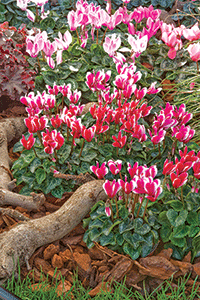By Jamie Gooch

Even clients who want low-maintenance plantings can benefit from a perennial service plan.
Perennials have long been the middle child of lawncare. Stuck between attention-hungry turf and the boastful blooms of annuals, perennials have dutifully emerged, year after year. That low-maintenance dependability is a trait that many homeowners seek in a landscape, and because breeders have been busy adding showiness, perennials are becoming more and more popular. Landscape contractors can offer perennial services that will help make the plants attractive from a business perspective as well as an aesthetic one.
“It’s a really nice niche to pursue,” says Ellen Vincent, an environmental landscape specialist in Clemson University’s Horticulture Department. “Annuals are easy. They’re kind of no brainers. It’s the plant connoisseur who will learn about perennials.”
She says landscape contractors who take the time to educate themselves about the perennials in their region will find that the two- to four-week bloom time of perennials of yore has been extended to an entire season in some new varieties.
They’ll also learn that low-maintenance doesn’t mean no maintenance. Many homeowners will be willing to pay for perennial expertise, from installation through to a recurring maintenance schedule.
Perennial planting prep
Ensuring the soil is ready to support plant life is the most important step to installing any bed, and perennials are no exception. Landscape contractors can provide soil testing services, as well as expertise on which plants should be placed where, depending on their soil, sun and water requirements, and their shape, height, color and texture.
“We used to try to change the soil situation to fit our needs, but that’s not sustainable,” Vincent says. “Now we’ve learned to work with the site as is, and only change it if absolutely necessary.”
One type of soil that may necessitate change is compacted ground. Without oxygen, soil can’t hold moisture. If a bed must be planted in compacted ground, the soil should be remediated first and whatever activities caused the compaction need to be avoided.

“Making sure soil does not become compacted in the first place is the No. 1 duty of landscape professionals,” says Vincent. Using equipment or even foot traffic on saturated soils can cause compaction.
Beyond soil preparation concerns, landscape contractors should help ensure their clients will receive season-long interest from their perennial plantings — both from blooms and foliage.
“Perennial connoisseurs are all about foliage,” says Vincent. “Foliage needs to be talked about as much as bloom. Blooms may not last the whole season, so attractive foliage is a selling point.”
Installation know-how
Once the soil is ready and the right perennials have been chosen for the space, putting them in the ground is just one step of the installation process. Ensuring plants get established is another service landscapers can offer with perennials.
“Making sure that installed plants receive moisture until the roots are established is critical,” Vincent says. “Even with plants that are drought tolerant, they still need watered until they’re established. That could be three weeks or three months, depending on the part of country you’re in.”
Mulching helps to retain moisture and may need to be applied more than once per season, depending on the region. That’s another opportunity for landscapers to connect with clients. Mulch may also help alleviate the need for fertilization.

Weeding is perhaps the most labor intensive maintenance involved with perennials. Landscapers can offer herbicide treatments, and some clients might be interested in contracting for hand weeding services.
Once perennials are installed and established, landscapers still have an opportunity to provide a service to their clients. By definition, a plant only needs a lifecycle of three years to classify as a perennial. Perennials do need to be replaced.
Even longer-lived varieties should be separated every three years.
“Maintenance firms can use that to their advantage,” Vincent says. “You can tell the client, ‘In three years, we’ll come back and divide the plants for you.’ That’s long-term, repeat business.”
Capitalizing on perennials requires knowing how various plants perform in your region and soil conditions, then communicating their benefits to clients. Becoming a perennial expert takes time, but local botanical gardens, commercial growers and websites such as the Lady Bird Johnson Wildflower Center’s (wildflower.org) can help.
“If you put together all the info about the area, customers, soils and plants, that enables you to really know your environment,” Vincent says. “All that info gets synthesized, and if you think of the ecosystem while you’re doing business, then you’ll make good decisions.”
Gooch is a freelance writer and editor based in Northeast Ohio.
Photos: Syngenta Flowers and PanAmerican Seed

